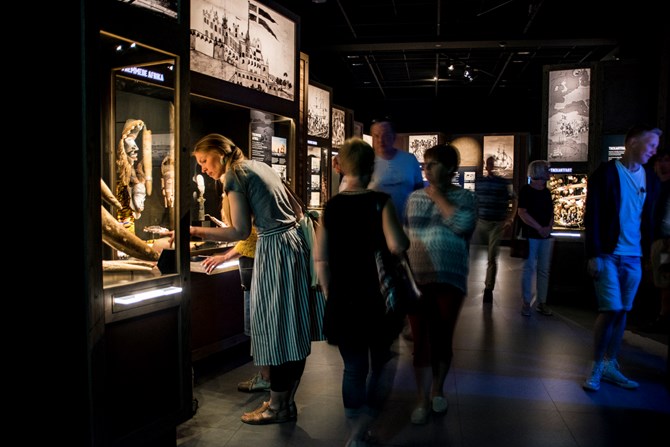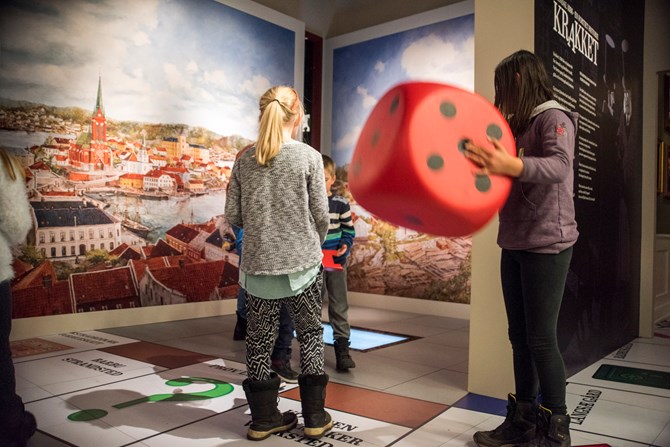


Traces of Life
Traces of Life’ presents traces of life in Eastern Agder from the Stone Age, Bronze Age and Iron Age. The exhibition covers the period from when the first humans arrived in the area until the end of the Viking Age. The exhibition focuses on the eastern part of Agder but is also relevant to the rest of the Agder region.
Traces of Life is filled with unique objects, activities for children, digital info stations and magical animations.
The exhibition is broadly based on KUBEN’s own archaeological collection. In addition to our own archaeological artefacts we have also been able to borrow objects from the Department of Cultural History at the University Museum in Bergen.
Every year archaeological objects are uncovered by both archaeologists and members of the public. The section of the exhibition called “New traces of life!” displays recent archaeological finds from the region.
Enslaved
This exhibition tells the story of the final voyage of the slave ship «Fredensborg». The frigate «Fredensborg» left Copenhagen in June 1767. Equipped for a triangular trade voyage, the ship was loaded with weapons, gunpowder and spirits, which were to be traded for African slaves. The slaves were to be transported to St. Croix in the Caribbean, and valuable sugar brought back to Copenhagen. But the «Fredensborg» never came home. She was wrecked off Tromøy on December 1st, 1768.
The exhibition also focuses on slavery today. Who made your things? Slavery still exists, and it also affects you.
Childhood
Get a glimpse of how it was to be a child in the 20th century. The exhibition Barndom (Childhood) is made primarily for children, and it has several activities for the kids. You’ll find a combination of fun and facts for children and adults. You can travel with a time machine, and then try to milk a cow, raise a sail, sing skipping-rope rhymes or simply dress up in old and fancy costumes.
The white sails
Stories from the final years of Norways sailingships. 150 years ago, Norway had the third largest merchant navy in the world, and Southern Norway was home to the bulk of the country’s sailing ships. Agder’s vast forests provided timber for shipbuilding. The Golden Age was replaced by periods of political and economic crisis, and sailing ships disappeared from the fleet. Steamships were the future.
The exhibition is based on KUBEN’s sailing ship archive, as a part of Norway's document heritage, a national version of UNESCO's Memory of the world program.
Open Storage - Samples from our Collections - City Life
The bottom two floors of KUBEN consist of an artefact archive. The archives are rooms where artefacts can be kept when not on display. Our archives comprise of over 50,000 artefacts. We have dreamed for a long time of being able to display the wide range in our collection. Therefore we have created the exhibition 'Open Archive'.
In January 2023 a new exhibition titled «City Life» opened in «Open Storage». «City Life» is a celebration of the 300th Anniversary of the cities Arendal and Risør.
The Bank Crash
The bank crash in Arendal came like a thunderbolt one fine autumn day in 1886. Fraud, excessive borrowing and favouritism led to a bank crash and bankruptcies. The working class organised, and in October, there was almost a revolution in the small town.
Arne Vinje Gunnerud sculpture
Arne Vinje Gunnerud was a great Norwegian sculptor who, for the majority of his life, lived in Arendal. Through prehistoric art and Norse mythology he discovered metaphors that also could describe modern issues. Gunnerud worked predominantly in bronze, wood and stone. He was very productive and he had many exhibitions both at home and abroad.
Behind the Façade
A daring and revealing exhibition about the secret lives of the Arendal elite in the early 19th century. The exhibition is based on the poet Conrad Nicolai Schwach’s manuscript “Recollections of my Life”, which in 2016 was added to Norway’s Memory of the World register.
Schwach lived in Arendal between 1821 and 1830. During this time he was considered to be one of Norway’s foremost poets. In the manuscript, Schwach gives an unvarnished and critical account of Arendal at the time. Visitors to the exhibitions will be able to discover a different side of the city’s elite – one characterised by lust, vice, intrigue and envy.
The exhibition is aimed at an adult audience.
Do you dare look behind the façade?





